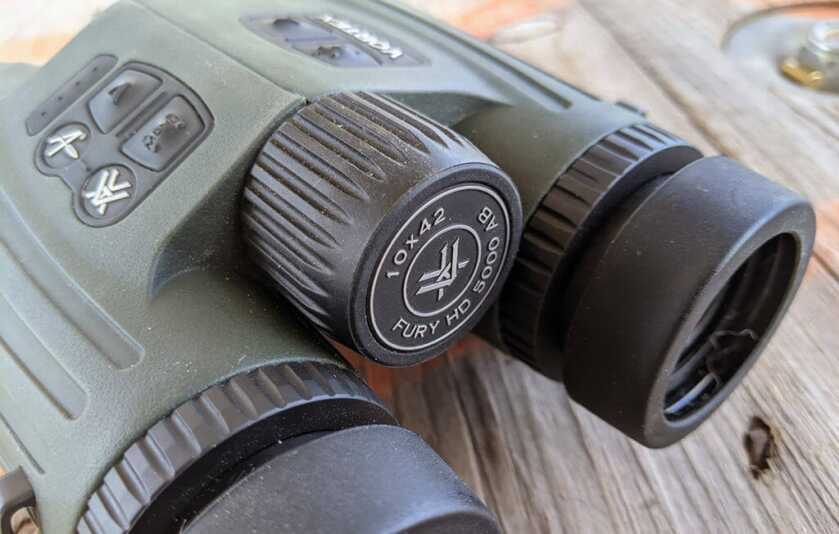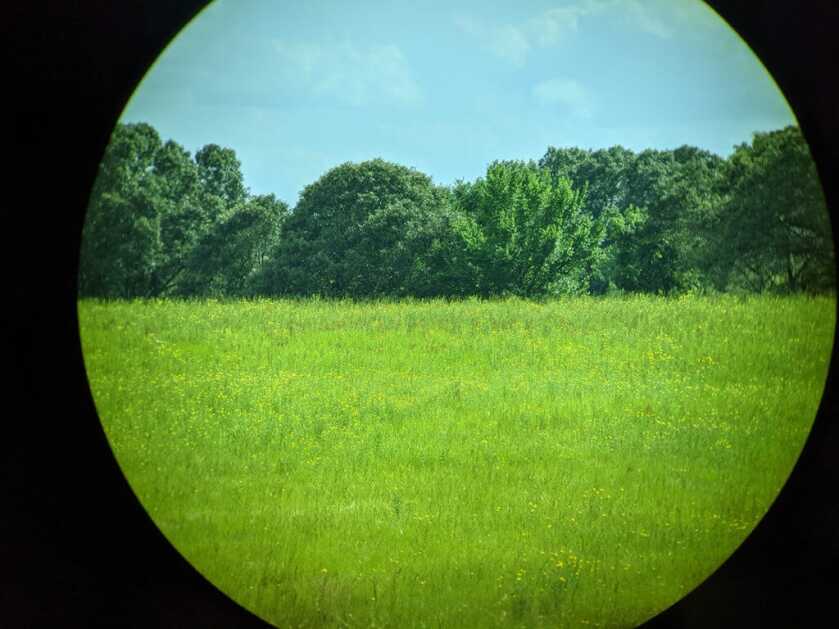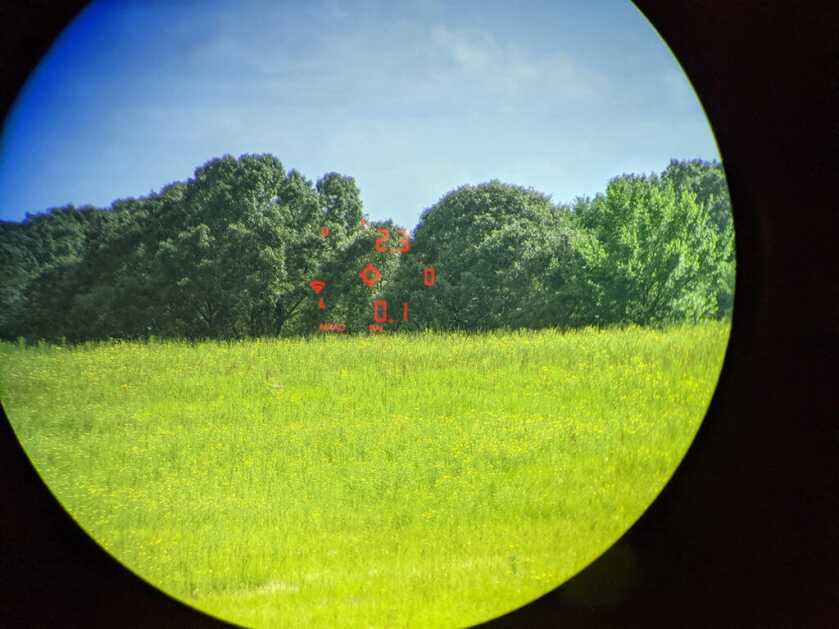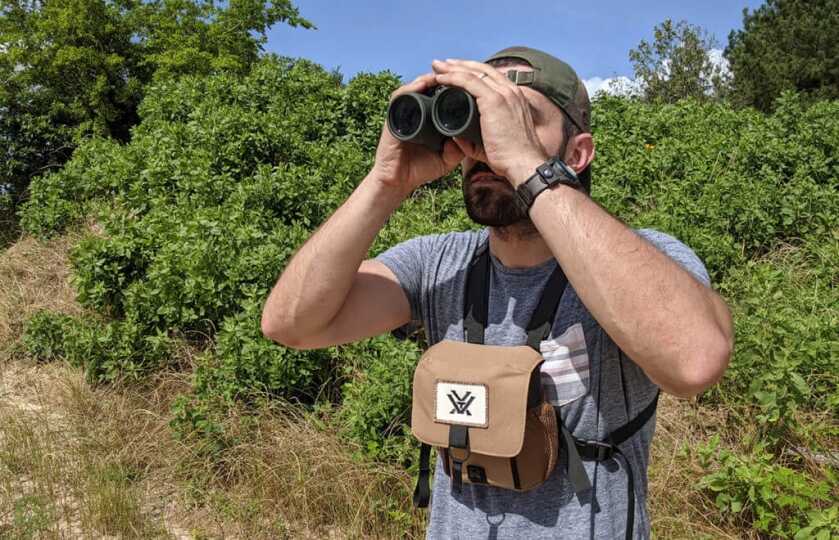
I’ll say at the outset that the title of this review is a lie. In order to do a “full review” of the new Vortex Fury binos, I’d need a lot more copy space than my editor is going to give me. The Vortex Fury HB 5000 AB is so loaded with features and functionalities that Vortex put out an entire nine-part series of 10-minute videos just to outline its basic functions. Carrying the Fury is like carrying around a NASA engineer in your pocket, and I’ve had a blast learning its ins-and-outs since Vortex released the product in January.
The Fury HB 5000 AB is a range-finding binocular with a built-in heads up display that can provide holdover and windage adjustments for a reflective target out to 5000 yards, trees out to 2400 yards, and deer out to 1600 yards. It provides this functionality with the help of an Applied Ballistics Elite solver, which uses distance, temperature, elevation, humidity, wind, and other environmental factors to provide a precise point of aim for each shot.
The real-world applications of this are obvious enough. Rather than shuffle back and forth between binoculars, a range finder, a ballistics solver, and a weather meter, hunters and shooters can get an exact adjustment using only the Fury (as long as a weather meter is connected via Bluetooth—more on this below). If you set it up correctly, it’ll give you the right windage and holdover for a first-shot hit at almost any distance and in almost any weather condition.
At a cool $1999.99 MSRP, the Fury is, as I like to tell my wife, an investment. You can find it for something closer to $1,500 on other websites, but it’s the kind of high-quality, super helpful gear that promises to pay for itself in rung steel and wild game meat.


Specifications
Magnification: 10x
Objective Lens Diameter: 42 mm
Eye Relief: 16 mm
Exit Pupil: 4.2 mm
Linear Field of View: 321ft/1000 yds
Angular Field of View: 6.1 degrees
Close Focus: 18.5 feet
Interpupillary Distance: 58-72 mm
Height: 5.8 inches
Width: 5.0 inches
Weight: 32.4 oz
Click here to check out the Fury HB 5000 AB.
Features, Features, Features
The Fury binos can be used as traditional binoculars, and in that capacity, they’re excellent. The glass is clear and anti-reflective, and I found the resolution and contrast to be top-notch even at long distances. Like the previous iteration of the Fury, the Fury AB features a tough, scratch-resistant exterior and fog-proofing over a wide range of temperatures.

But you don’t drop 2K on these binos to ignore their electronic functionality. I won’t reinvent the wheel and go through the entire setup , but here’s the first video in the Vortex series:
The setup process is relatively painless with the help of these videos, though you might struggle if you’re not comfortable using a smart phone. The Fury’s settings and features are mostly operated via the Vortex Fury HD app, including firearm profiles, environmental information, and target parameters.
Again, the Fury offers a near-infinite number of features, but here are a few I’ve found helpful (or otherwise).
Ranging
Besides magnification, instant ranging is the Fury’s most useful feature. Users take a range by placing the reticle on an object and pressing the “Measure” button on the top of the binos. The range appears in yards in the bottom portion of the heads-up display, and the units can be changed to meters. I’ve found that this feature works flawlessly. No complaints here.

Windage and Holdover
Once the binos have a range, they provide windage and holdover adjustments based on whatever firearm profile is currently selected. The binos can provide those adjustments for three different firearm profiles (A, B, or C), which is more than enough for any given hunt or range trip. In addition, users can swap out firearm profiles via the app.
Users construct firearm profiles by inputting data like bullet speed, ballistic coefficient, scope height, and zero range. The built-in bullet library has hundreds of factory cartridge options to choose from, so unless you’re using handloads, it’s likely your favorite cartridge is already there.

Environmentals
The Fury includes on-board sensors that measure temperature, pressure, humidity, and elevation, and it automatically factors those variables when it produces the shot solution. Wind, however, is a different story. The Fury can be connected via Bluetooth to a Kestrel, which will provide additional environmental information, including wind. If you have a Kestrel, that’s the simplest way to go.
If you don’t have a Kestrel, you’ll have to input wind information yourself. This can be done using one of two modes: Full Crosswind Mode or Wind Bearing Capture Mode. In Full Crosswind Mode, the Fury assumes the wind is coming from either the full 3 o’clock or 9 o’clock positions. Users enter the wind speed relative to those directions. So, if your target is at 12 o’clock, and a 10mph wind is coming from 2 o’clock, you’d enter a 7(ish) mph wind coming from the 3 o’clock position. This mode is designed for quick but less precise wind calculations.

In Wind Bearing Capture Mode, users can capture the exact direction of the wind, and the Fury calculates windage adjustments based on the direction of the target relative to the wind. Users face directly into the wind, press the “wind bearing capture” button, enter the wind speed, and go from there. This is the mode I used most frequently, and I found it to be super accurate.
The need to enter wind speed manually makes the Fury AB not quite as user-friendly as it might first appear. I realize this is ridiculously nit-picky. The fact that such a device exists in the commercial market is astounding, and it does virtually everything else you need it to do. But I found that entering wind is the most complicated component of using the Fury, so it’s worth taking the time to practice before relying on the binos to make a critical shot.
For more info, check out the instructional video below.
Velocity on Impact
This is one of the features that hasn’t received much attention, but it could be the Fury’s most useful in the field. Along with providing windage and holdover adjustments, the Fury app’s ballistics display calculates the velocity on impact and the energy on impact. For long-range work out West, this feature could be invaluable.
Most bullet manufacturers publish how fast a bullet must be travelling to reach full expansion. Federal’s Trophy Copper line, for example, must be travelling at 1,800 fps on impact in order to reliably expand. Hunters can research ahead of time what their maximum effective range will be with any given bullet, but the Fury provides that information in the field in real time. Knowing (or being reminded) of a bullet’s velocity on impact can give hunters the confidence they need to take an ethical shot—or the info they need to pass.
At the Range
In my mind, first-shot hits are the gold standard for a tool like the Fury AB. With so much data and computing power, these binos should be able to provide exact adjustments for any cartridge and environmental situation. As long as the shooter does his or her job and the firearm functions properly, I expect to land shots on target at any reasonable distance.

I had a chance to test the Fury’s functionality at Texas Tactical Training Center here in East Texas. My goal was simple: land the first shot within the kill zone of a large steel animal (about 18”) on the first shot at the 600 and 700-yard targets.
Thanks to the Fury’s range-finding function, I realized that the targets were at precisely 615 and 720 yards. The Fury calculated holdover based on that data along with all the other environmental meters in the binos.
The wind wasn’t in my favor. It was gusting between 5 and 20mph, and it was coming from about 10:30—not quite a headwind, but pretty close. When I inputted this data into the Fury, it didn’t recommend any windage adjustments. On my own, I would have estimated at least a little bullet movement, but I went with it.
My first shot at 615 yards hit the man-sized target about three inches to the right of my point of aim, and my first shot at 720 yards hit about four inches to the right. Both hits were well within the kill zone of any large North American game animal, and they would have done the job on deer, too.


I call that a success, especially considering the fact that I was shooting the new Springfield Model 2020 for only the second time in my life. I had done a little cartridge testing, and I knew the velocities for each load, but I was unfamiliar with the rifle. Left to my own devices (literally, like three different devices), I doubt I would have gotten on target so quickly.
Conclusion
You can achieve the functionality of the Vortex Fury AB without spending $2,000. You can purchase a cheaper set of binos along with a range finder, barometer, altimeter, thermometer, and a humidity gauge. You can pair those gauges with a wind meter and a ballistics calculator and get to more or less the same place as the Fury.
But you’ll have to switch back and forth between your binos and your range finder and manually enter all the environmental data. When you’re on a once-in-a-lifetime hunting trip, and your target animal is five seconds from walking into the tree line, you need windage and holdover information in short order. The Vortex Fury HB 5000 AB can give you that info, and I guarantee you won’t be thinking about the price tag when you walk up to that trophy animal.
Click here to check out the Fury HB 5000 AB.

I have to say what a huge disappointment it is that manufactures can’t figure out that 1/3 of males are red green color blind. Looked at the shots that were supposed to show the numbers and could not see them at all. You could at least use bright green for contrast. Get a clue, you are leaving out a large portion of your market.